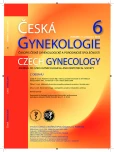Accuracy of placenta accreta ultrasound prediction in clinical work
Authors:
Z. Žižka; P. Beitlová; P. Hubka
; Tomáš Fait
; P. Drahorádová; P. Calda
Authors‘ workplace:
Gynekologicko-porodnická klinika 1. LF UK a VFN, Praha
přednosta prof. MUDr. A. Martan, DrSc.
Published in:
Ceska Gynekol 2012; 77(6): 498-501
Overview
Objective:
To evaluate accuracy of placenta accreta ultrasound prediction in own group of patiens.
Design:
Retrospective analysis.
Setting:
Departement of Obstetrics and Gynaecology, 1st Faculty of Medicine, Charles University and General Faculty Hospital, Prague.
Methods:
We retrospectively evaluated a group of 12 patients, that had undergone ultrasound examination during pregnancy at our department and afterwards had been diagnosed during caesarean section (CS) with placenta accreta (years 2010–2011).
Results:
11 out of 12 women in our group had at least one of the risk factors (placenta praevia, previous SC, history of uterine surgery). During US examination, suspicion of placenta accreta was raised at 7 out of 12 women.
In 5 cases we have performed elective CS and in 7 cases CS was done after onset of the labour (in 4 cases the reason was severe bleeding). The peripartal blood loss ranged from 500 ml to 7000 ml. Due to life threatening bleeding in 5 cases (42%), abdominal hysterectomy was performed. Placenta accreta was successfully diagnosed in cases with hysterectomy by US in 80 percent (4/5). Histological examination of the uterus confirmed in 2 cases placenta accreta, in 2 cases placenta increta and in 1 case placenta percreta.
Conclusion:
US diagnosis of placenta accreta is possible, with success rate of 58 percent (7/12). Early diagnosis helps to properly set up CS and consult the patient about the risk of unavoidable hysterectomy.
Key words:
diagnosis, placenta accreta, ultrasound.
Sources
1. Al-Serehi, A., Mhoyan, A., Brown, M., et al. Placenta accreta: an association with fibroids and Asherman syndrome. J Ultrasound Med, 2008, 27, 11, p. 1623–1628.
2. Comstock, CH. Antenatal diagnosis of placenta accreta: a review. Ultrasound Obstet Gynecol, 2005, 26, 1, p. 89–96.
3. Dwyer, BK., Belogolovkin, V., Tran, L., et al. Prenatal diagnosis of placenta accreta: sonography or magnetic resonance imaging?J Ultrasound Med, 2008, 27, 9, p. 1275–1281.
4. Giambattista, E., Ossola, MW., Duiella, SF., et al. Predicting factors for emergency peripartum hysterectomy in women with placenta previa. Arch Gynecol Obstet, 2012, 285, 4, p. 901–906.
5. Hayes, E, Ayida, G, Crocker, A. The morbidly adherent placenta: diagnosis and management options. Curr Opin Obstet Gynecol, 2011, 23, 6, p. 448–453.
6. Levine, D., Barnes, PD., Madsen, JR., et al. Fetal central nervous system anomalies: MR imaging augments sonographic diagnosis. Radiology, 1997, 204, 3, p. 635–642.
7. Lim, PS., Greenberg, M., Edelson, MI., et al. Utility of ultra-sound and MRI in prenatal diagnosis of placenta accreta: a pilot study. Am J Roentgenol, 2011, 197, 6, p. 1506–1513.
8. Lutomski, JE., Byrne, BM., Devane, D., Greene, RA. Increasing trends in atonic postpartum haemorrhage in Ireland: an 11-year population-based cohort study. BJOG, 2012, 119, 3, p. 306–314.
9. Wu, S., Kocherginsky, M., Hibbard, JU. Abnormal placentation: twenty-year analysis. Am J Obstet Gynecol, 2005, 192, 5, p. 1458–1461.
10. Yarandi, F., Eftekhar, Z., Shojaei, H., et al. Conservative management of placenta increta: case report and literature review. Acta Med Iran, 2011, 49, 6, p. 396–398.
Labels
Paediatric gynaecology Gynaecology and obstetrics Reproduction medicineArticle was published in
Czech Gynaecology

2012 Issue 6
Most read in this issue
- Monochorionic biamniotic twins with a common yolk sac in the first trimester ultrasound scan – is there a higher risk of a congenital defect?
- Homebirth in Czech Republic
- Conservative method in treatment of placenta accreta – two case reports
- Dehiscence of laparotomy after hysterectomy – wound management
